|
|
|
Sort Order |
|
|
|
Items / Page
|
|
|
|
|
|
|
| Srl | Item |
| 1 |
ID:
077019
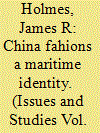

|
|
|
| 2 |
ID:
190950
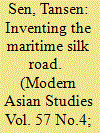

|
|
|
|
|
| Summary/Abstract |
Although inspired by the nineteenth-century term ‘Silk Road(s)’, the phrase ‘Maritime Silk Road’ has its own origins, connotations, and applications. This article examines the emergence of the latter term as a China-centric concept and its various entanglements since the early 1980s, involving the People’s Republic of China’s (PRC) political bodies, academia, the ‘open door’ policy, the pursuit of World Heritage listings, and the current ‘Belt and Road Initiative’. These entanglements, the article contends, have resulted in the emergence of what could be called a ‘Maritime Silk Road’ ecosystem in the PRC. The analysis of this ecosystem presented in the article reveals not only the processes through which a narrative on China’s engagement with the maritime world has been constructed over time, but also its association with issues of national pride, heritage- and tradition-making, foreign-policy objectives, and claims to territorial sovereignty. As such, the ‘Maritime Silk Road’ must be understood as a concept that is intimately entwined with the recent history of the PRC and distinct from its nineteenth-century antecedent, which was used as a label for overland connectivity.
|
|
|
|
|
|
|
|
|
|
|
|
|
|
|
|
| 3 |
ID:
147195
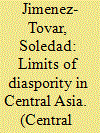

|
|
|
|
|
| Summary/Abstract |
This article shows different ways of defining, understanding and performing ‘diaspority’ in the border region of Kordai (Kazakhstan) and Tokmok (Kyrgyzstan). Taking the example of Dungan people, as the Sinophone Muslims are known in Central Asia, both academic and political definitions of the concept of ‘diaspora’ are compared. This ethnographic account problematizes Kazakhstani Shaanxi Dungan ‘diaspority’. Together with this, the political definitions of ‘diaspora’ are also analysed. I show that while in China and Kazakhstan the definitions of the Dungans as a ‘diaspora’ of ‘China’ are somewhat complementary, once the Shaanxi Dungan emic perspective is taken into account, this concept becomes rather problematic. The kinds of diaspority defined by the states involved are ways of implementing particular cultural hegemonies that legitimate the two political regimes analysed in this article. Concurrently, this dual diaspority is used by the Dungan people in distinct ways in defining their own identities. Nevertheless, I show in this article that the ‘Chinese card’ is not necessarily played by all Dungans. Moreover, there are some Dungans for whom ‘Chinese-ness’ is not even relevant.
|
|
|
|
|
|
|
|
|
|
|
|
|
|
|
|
| 4 |
ID:
074431
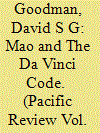

|
|
|
|
|
| Publication |
2006.
|
| Summary/Abstract |
During the last decade three books have had a disproportionate impact on China Studies because of their controversial interpretations: Jenner's The Tyranny of History, which predicts the disintegration of the Chinese state; Menzies' 1421: The Year China Discovered the World, which describes how Chinese sailors circumnavigated the globe well before any Europeans; and Jung Chang and Jon Halliday's biography Mao: The Unknown Story. All are revisionist histories that amongst other (usually controversial) conclusions suggest there has been a conspiracy to keep the information they convey hidden. Considering their arguments and the manner of their enquiry and expression is interesting in more general ways about the construction of narrative and the nature of conspiracy, as well as about the lessons for academic research.
|
|
|
|
|
|
|
|
|
|
|
|
|
|
|
|
| 5 |
ID:
089888
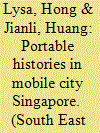

|
|
|
|
|
| Publication |
2009.
|
| Summary/Abstract |
'Singapore stories' are frequently tales of departure and arrival, but in the midst of this the nation-state has set out to construct a sense of permanence, and with that a future, such that the transits might become meaningful in the national narrative. Those who leave are supposed to be overseas Singaporeans; those who come, new Singaporeans. To this end, the country could do with an icon of mobility such as Zheng He, who evokes history, character and expansiveness. His legendary journeys stimulated imaginations and marked the apex of the navigational technology of his day. In mainstream historical accounts, he was a figure of peace, representing the mighty yet benevolent Middle Kingdom, and even a folk deity. The 600th anniversary of the launching of the first voyage in 1405 was celebrated throughout China and the Chinese diaspora. In Singapore, the Singapore Tourism Board and private agencies rode on the worldwide publicity generated by the 2002 book by Gavin Menzies - arguing that China discovered America before Columbus and circumnavigated the world before Magellan - to host a range of mega-events, including an international exhibition based on the book's claims. However, the celebrations were dampened by the efforts of Singapore-based Geoff Wade, a historian of Ming dynasty China, who has tirelessly disputed such claims. Other scholars and businessmen in Singapore have also entered the fray. From Raffles to Zheng He, Singapore's search for history serves only to emphasize its historical rootlessness.
|
|
|
|
|
|
|
|
|
|
|
|
|
|
|
|
| 6 |
ID:
174939
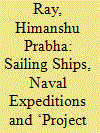

|
|
|
|
|
| Summary/Abstract |
In recent years, sailing ships of the Indian Navy have been increasingly involved in diplomatic missions and cultural voyages across the world, in addition to their primary purpose of providing practical training in navigation techniques and seamanship. These three-masted barques built at the Goa Shipyard and used by the Indian Navy are very different from wooden sailing vessels that traversed the Indian Ocean in the premodern period prior to the development of steamship navigation in the nineteenth century. Nonetheless, these distinctions have often been blurred as these modern naval ships have been utilised to recreate historical ‘expeditions’ such as the much-celebrated Chola invasion of Srivijaya in the Indonesian archipelago. Nor is India the only country to be involved in promoting this ‘popular history’ for contemporary geopolitical interests, as is evident from China’s efforts to rebuild ships used in the Voyages of Admiral Zheng He across the Indian Ocean. What gets short shrift in the process is investment in research in underwater archaeology and the discovery and preservation of shipwreck sites. This article highlights the urgent need for interdisciplinary research in premodern shipping and seafaring activity beyond the rhetoric of valorising national heroes.
|
|
|
|
|
|
|
|
|
|
|
|
|
|
|
|
|
|
|
|
|